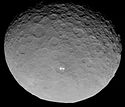Exoasteroid

(James Webb Space Telescope; 8 May 2023)
An exoasteroid, exo-asteroid or extrasolar asteroid, is an asteroid outside the Solar System. Exoasteroids (and related exoasteroid belts) were considered to be hypothetical, but scientific study and thorough analysis have provided evidence for their existence.[1]
Evidence
Scientists propose that the formation of exoasteroids often results from the fragmentation of exoplanets by gas giants. These exoasteroids are presumed to be the remnants of smaller celestial bodies that endured the demise of their parent exoplanet. Analogous processes are hypothesized to have occurred during the formation of our Solar System. [2][3]
NASA has conducted studies affirming that the presence of asteroid belts around stars is a common phenomenon in nearly any solar system hosting planets comparable in size to the outer and inner planets of our Solar System.[3]
History
In December 1988, a study conducted by Benjamin Zuckerman and Eric Becklin, American astrophysicists, detected a substantial circumstellar disc encircling the white dwarf star G 29-38. This discovery emerged from a near-infrared survey involving the examination of 200 white dwarfs. [4] Zuckerman and Becklin further conducted investigations on the white dwarf star, revealing that the circumstellar disc emitted significant radiation in the 2 to 5 micrometer range. This discovery hints at the possibility of exoasteroids interacting with radiant matter and being ejected into space. [5] Subsequent observations in 2004 by the Spitzer Space Telescope unveiled the presence of a dust cloud enveloping G 29-38. This phenomenon might have originated from the disintegration of an exocomet or exoasteroid as it interacted with the white dwarf over time. [6] Spitzers observations further proved that exoasteroids could exist.
In May 2023, the James Webb Space Telescope captured images of Fomalhaut,[7] a young star located 25 light-years (ly) from Earth. Scientists conducted simulations and tests on Fomalhaut’s asteroid belt, suggesting that it might have formed as a result of collisions involving larger celestial bodies.[7][clarification needed]
Another notable star hosting an asteroid belt is the white dwarf star WD 0145+234; it is hypothesized that WD 0145+234 once hosted an exoasteroid or exoplanet in orbit around it, which was subsequently disrupted, leading to the formation of a substantial exoasteroid belt. Due to the star's dimensions, scientists infer that the accretion disk surrounding WD 0145+234 is highly active, resulting in the regular disruption of exoasteroids by the star's gravitational pull. In 2018, astronomers observed a 10% increase in the star's mid-infrared light, indicative of the recent destruction of an exoasteroid, which led to the formation of a cloud of metallic dust partially obscuring WD 0145+234 from Earth's view. [8]
Detection

In 2013, astronomers made an unprecedented discovery of fragmented remnants of an exoasteroid orbiting the star GD 61. Upon detailed examination, scientists determined that the asteroid possessed a surface rich in water, comprising approximately 26% water by mass, a composition akin to the surface water, primarily in the form of ice, found on the dwarf planet Ceres. This revelation suggests the potential existence of an exoplanet with liquid water around the star at some point in its history. It is postulated that the asteroid met its demise due to interactions with its star, leading to its fragmentation and subsequent formation of an asteroid belt around the star.
Following this discovery, scientists utilized the Cosmic Origins Spectrograph aboard the Hubble Space Telescope to analyze the chemical composition of the asteroid. Their analysis unveiled the presence of magnesium, silicon, iron, and oxygen within the asteroid’s water.[9]
Proposed observational methods
Exoasteroids can be detected through various methodical processes. The transit method is a common technique used by scientists to discover extrasolar objects as they pass in front of their host star, providing scientists with the opportunity to observe their shape. Spectroscopy serves as another valuable tool for identifying distinctive characteristics of exoasteroids, enabling scientists to detect surface features and gain a deeper understanding of these celestial bodies. Additionally, other valuable techniques include remote sensing and data from past missions to minor planets.
See also
References
- ^ Enking, Molly (11 May 2023). "James Webb Telescope Reveals Asteroid Belts Around Nearby Young Star - The findings suggest the star Fomalhaut may have orbiting planets hidden among its rings of debris". Smitjhsonian. Archived from the original on 31 December 2023. Retrieved 31 December 2023.
- ^ "Asteroids: Facts". nasa.gov. Retrieved 31 December 2023.
- ^ a b Gronstal, Aaron (26 January 2023). "Exo-Asteroids and Habitability around M-Dwarfs". NASA. Archived from the original on 31 December 2023. Retrieved 31 December 2023.
- ^ A low-temperature companion to a white dwarf star, E. E. Becklin & B. Zuckerman, Nature 336 (Dec. 15, 1988), pp. 656-658
- ^ Excess infrared radiation from a white dwarf - an orbiting brown dwarf? B. Zuckerman & E. E. Becklin, Nature 330, (Nov. 12, 1987), pp. 138-140
- ^ The Dust Cloud around the White Dwarf G29-38, William T. Reach, Marc J. Kuchner, Ted von Hippel, Adam Burrows, Fergal Mullally, Mukremin Kilic, and D. E. Winget, Astrophysical Journal 635, #2 (December 2005), pp. L161–L164.
- ^ a b "Webb Looks for Fomalhaut's Asteroid Belt and Finds Much More". nasa.gov. 8 May 2023. Retrieved 30 December 2023.
- ^ Letzter, Rafi (17 October 2019). "An Asteroid-Smashing Star Ground a Giant Rock to Bits and Covered Itself in the Remains". livescience.com. Retrieved 31 December 2023.
- ^ "Watery asteroid discovered in dying star points to habitable exoplanets". phys.org. 10 October 2013. Retrieved 31 December 2023.
External links

- "Alphabetical list of minor planet names". Minor Planet Center. International Astronomical Union.
- "Asteroid articles in Planetary Science Research Discoveries". Planetary Science. University of Hawaii.
- "JPL Asteroid Watch site". Jet Propulsion Laboratory.
- NASA Asteroid and Comet Watch site
- Asteroid size comparisons (video; 2:40) on YouTube
- v
- t
- e
- Trojans
- Interior to Earth
- Near-Earth
- Between Earth and the main belt
- Asteroid belt
- Outer Solar System, does not include distant minor planets
- Centaurs
- Exoasteroids
| Orbital | |||||
|---|---|---|---|---|---|
| Spectral |
|
 Category
Category




























